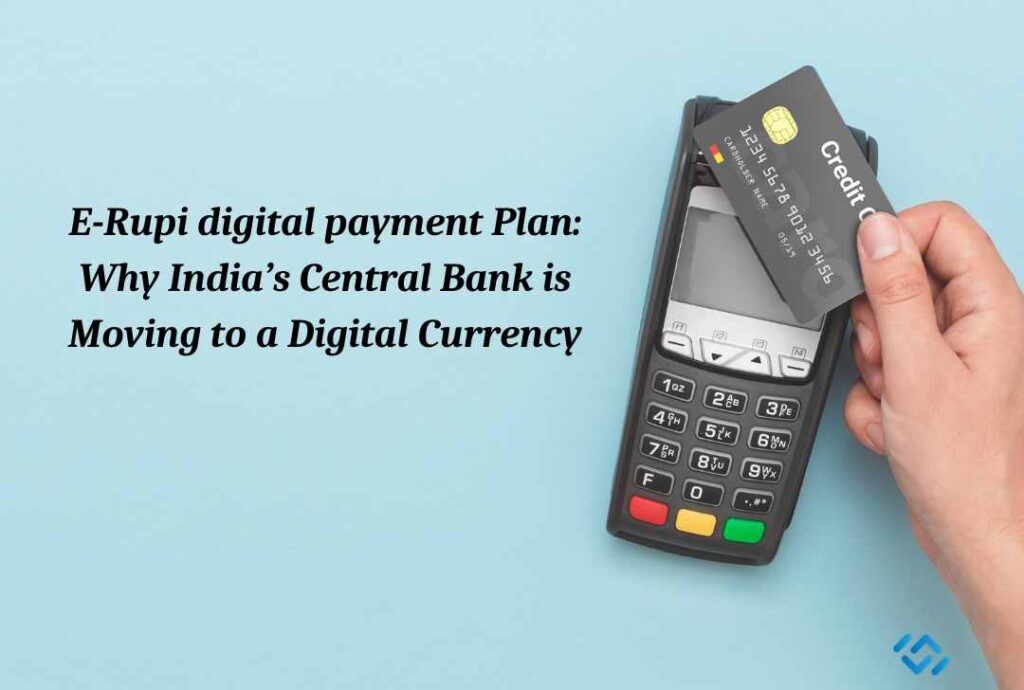India’s central bank, the Reserve Bank of India (RBI), is making strides towards digitalizing its currency by introducing a new E Rupi digital payment system. This move is part of the RBI’s larger initiative to build a digital payment ecosystem in India and to provide greater access to financial services for citizens. In this blog post, we’ll explore why the RBI is taking this step and how it will benefit citizens and businesses in India.
What is E-Rupi digital payment?
E-Rupi digital payments is a cashless and contactless technique. The users’ mobile devices receive the Quick Response (QR) code or SMS string-based e-voucher. At the service provider, the consumers can use the voucher without a card, a digital wallet, or internet banking access. The pre-paid nature of the system ensures prompt payment to the service provider without the need for a middleman.
The digital voucher intends to guarantee that financial support from the government reaches citizens directly and in a “leak-proof” manner. Financial inclusion of unbanked citizens and closing the digital divide are the primary goals and long-term ambition of e rupi digital payment.
It makes it possible for the government to offer financial assistance in the fields of healthcare, welfare, and medicine. With the actual Indian rupee still serving as the underlying asset, e-rupi differs from virtual currencies and is more akin to voucher-based payment systems due to the specificity of its function.
How will E-Rupi digital payment work?
The service recipient will receive the SMS string or QR code on his or her phone. The customer should present this code or string to the service provider (such as a hospital or PHC) so that it can be scanned. The payment would then be successful after a verification code was provided to the beneficiary’s phone and shared with the retailer.
The National Payment Corporation of India (NPCI), with assistance from the Ministry of Health and Family Welfare, the National Health Authority, and the Department of Financial Services, established the one-time payment mechanism.
Through their bank partners, any firm or government body can produce these e-vouchers. It functions somewhat similarly to a pre-paid gift card (paid for by the government organisation or ministry delivering the service) but is provided in the form of a QR code or an SMS string rather than a real card.
The method used to issue e-RUPI vouchers.
The NPCI created the e-rupi system on its UPI platform and integrated banks who will act as the issuing organisations. Governmental corporations and agencies will approach the partner banks and provide them with information about the recipients and the uses to which payments must be made.
The mobile numbers of the beneficiaries are used to identify them. Only the voucher, which is assigned to the merchant in the beneficiary’s name, will be delivered to the appropriate recipient. ICICI Bank, SBI, Axis, HDFC, Bank of Baroda, Punjab National Bank, Indus Ind Bank, and Canara Bank are a few of the partner banks.
e-RUPI India - features and benefits.
The users of this payment method are not need to have a bank account, a smartphone, access to internet banking, or even a card in order to use this service.
The fact that the beneficiary is not required to have a bank account is what sets e-rupi India apart from other digital payment systems. Higher adoption rates in rural areas and among economically disadvantaged groups of the population would result from this.
e rupi digital payment has a great deal of potential to assist small enterprises in directly taking advantage of numerous government programs.
The nation’s financial inclusion will be promoted through it. Additionally, it will guarantee that government services are provided to list mile recipients in a transparent manner and without the loss of benefits or funding. It will hasten the endpoint delivery that is transparent, targeted, and leakage-free.
Another benefit of e-rupi India is that it can be used by the government to fill in holes in its digital payments infrastructure. This will assist the government create a Central Bank Digital Currency and ensure its success.
e-rupi is simple, secure, and safe because it entirely protects the beneficiaries’ personal information.
Is e-RUPI India a form of digital currency?
E-rupi payment solution is not a form of digital currency. It is a social service voucher system that makes sure benefits are distributed promptly and accurately to the rightful recipients. However, in that the experience can assist the government learn more about the architecture of digital payments and the flaws in the system, it can be considered as a first step toward having a digital currency.
Uses:
Government Sector: It will be used to deliver services under programmes for providing drugs and nutritional support under Mother and Child Welfare programmes, drugs & diagnostics under programmes like Ayushman Bharat Pradhan Mantri Jan Arogya Yojana, fertiliser subsidies, etc. It is expected to ensure a leak-proof delivery of welfare services.
Private Sector: These digital vouchers can also be utilised by the private sector as a component of their employee welfare and Corporate Social Responsibility (CSR) initiatives.
Digital currencies are predicted to succeed in India with the following four reasons:
Increasing Penetration: The use of digital payments is becoming more widespread throughout the nation, along with a persistent interest in using cash, particularly for low-value transactions.
High Currency to GDP Ratio: Another advantage of CBDCs is offered by India’s high currency to Gross Domestic Product (GDP) ratio.
The currency-to-GDP ratio, also known as the currency-to-CIC to GDP ratio or just the currency-to-GDP ratio, displays the value of money in circulation as a percentage of GDP.
Proliferation of Virtual Currencies: From the perspective of the central bank, the spread of private virtual currencies like Bitcoin and Ethereum may be yet another factor making CBDCs significant.
Can Serve as a Cushion: In a world of unstable private virtual currencies, central bank digital currencies might also protect the broader public.
The government is already working on creating a Central Bank Digital Currency, and the introduction of e-RUPI payment solution might make clear any weaknesses in the digital payments infrastructure that are essential for the future digital currency’s viability.





